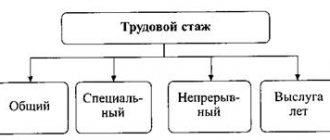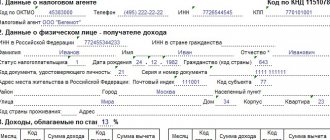01.07.2019
0
354
6 min.
Vacation compensation upon dismissal of a part-time employee is paid according to the same rules as for main employees, but with some nuances. In practice, if a citizen leaves work, difficulties arise when replacing leave at an additional place of employment with monetary compensation. To figure out how to act in such situations, we will consider what part-time work is, how leave is granted at a second place of employment, what rules are used to compensate for unused vacation time, in what cases this cannot be done, and what will happen if compensation is not paid.
How to determine the amount of compensation
Compensation is paid for all days of rest accumulated and unspent by those leaving (Part 1 of Article 127 of the Labor Code of the Russian Federation). It is calculated in the same way as vacation pay. Reimbursement can be calculated using the formula:
Example
K = Z*D,
Where:
- K - compensation for unused vacation to a part-time employee upon dismissal;
- Z - average daily earnings;
- D - vacation days that need to be compensated.
| Experience (months) | Compensation is made |
| From 11 | Entirely |
| From 5.5 to 11, if:• staffing is reduced;• an organization or structural unit is liquidated, reorganized;• the dismissed person is reassigned to another place;• called up for military service;• the dismissed person is recognized as professionally unfit. | Entirely |
| Up to 5.5 | Based on actual work time |
There is a separate category of workers who are compensated for two working days for each month worked. This includes employees hired on a fixed-term employment contract and seasonal workers. The calculation is made using the same formula, with the exception that working days are taken into account, not calendar days.
Features of granting leave to a part-time worker
A part-time worker is a person who, along with the main labor functions, performs other work in the same organization (enterprise, institution, individual entrepreneur) or for another employer beyond the established working day. The duration of part-time work cannot exceed 4 hours a day and, accordingly, 20 hours a week. Employment does not require consent or information from the manager at the main location. The main differences between part-time and combination
Important! Part-time work should not be confused with combination. Sometimes distinctions are made depending on the place of work. If additional employment is with the same employer, then this is a combination. If the other has a part-time job. This definition is incorrect. Part-time work can also be internal, i.e. with one employer. The differences lie in the work schedule - when combining, additional functions are performed during normal working hours, and when part-time, additional work is carried out outside of the working day.
Unlike part-time work, part-time work is carried out in excess of the established working hours
The specifics of regulating the labor of part-time workers have been defined. Article 286. Leave when working part-time
If the duration of vacation from the part-time employer is shorter than the main one, at the employee’s request, he is provided with additional days of rest without payment in accordance with the duration of rest at the main place. The employer does not have the right to refuse additional rest to a part-time worker under such circumstances.
Position of the Supreme Court. A part-time employee who has notified the manager of the need to grant him leave in connection with a vacation at the main place of work has the right not to appear at the workplace. Absence from work under such circumstances cannot be considered as absenteeism (clause \"d\". clause 39 of the Resolution of the Plenum of March 17, 2004 No. 2).
No specific features have been established when determining the duration of leave for a part-time employee. The minimum paid vacation is 28 calendar days. Additional leave for harmful conditions, special character, etc. is provided according to general rules. The exception is additional leave for irregular working hours. Part-time work does not imply the possibility of an irregular schedule. Calculation of compensation for unused vacation
What counts towards experience?
The HR department counts the intervals:
- going to work;
- travel on duty;
- own illness, caring for family members;
- weekly days off and official holidays;
- vacation periods, with the exception of child care;
- temporary downtime due to the fault of the employer with retention of wages;
- absenteeism, not passing a medical examination due to someone else’s fault;
- absenteeism associated with illegal dismissal from work;
- rest without pay, less than two weeks during the working year.
If, when calculating the length of service, the number of days turns out to be greater than or equal to 15, it is rounded up to the whole month. The smaller number is discarded.
As a rule, a part-time worker is accepted at 0.5 or 0.25 rates. This does not affect the calculation of length of service.
The following periods are excluded from the length of service:
- absenteeism;
- removal from duties due to the fault of the employee;
- child care up to 1.5 and 3 years old;
- rest without pay, in excess of two weeks during the working year.
Compensation upon dismissal of a part-time worker
Like an employee performing his job duties as a main employee, a part-time worker has a package of social guarantees provided for by current legislation. Certain guarantees protecting the rights of a part-time employee are also provided in the event of his dismissal. In this article, we will tell you what compensation for dismissal of a part-time worker consists of, in what cases and in what amount it can be claimed, and we will determine the procedure for calculating compensation for dismissal of a part-time worker.
From this article you will learn:
- what compensation is due to a part-time worker upon dismissal;
- what federal laws stipulate the right of a part-time worker to compensation upon dismissal;
- calculation of compensation upon dismissal of a part-time worker.
How to determine days due
For each year, an employee is granted at least 28 days of vacation in calendar terms. The subtleties of the calculation are explained in Art. 115-119 Labor Code of the Russian Federation.
An employee’s individual year begins on the date of entry into the organization. Intervals that are excluded from the work time shift the end of the period by the same number of days.
Example
Alenyev A.I. accepted 06/07/2016. If there were no gaps to exclude, the year end date will be 06/06/2017. If, for example, Alenyev A.I. missed 7 days, then the year must be extended until 06/13/2017.
According to the recommendations of Rostrud, for a full month, a part-time worker receives 2.33 days of guaranteed rest (28:12 = 2.33). If the duration of rest provided to the employee differs from the standard, the calculation will change.
Example
Zhuravleva N.V. 56 days of vacation are established. For a month, the number of unused days will be 4.67: 56:12 = 4.67 days.
A fractional number can be rounded up to a whole value without being guided by arithmetic rules (letter from the Ministry of Health and Social Development of the Russian Federation dated December 7, 2005).
Independent experts advise
Published in ACCOUNTING No. 22 (1062) dated JUNE 3, 2013
COMPENSATION FOR LEAVE FOR A PART-TIME WORKER
In 2013, an employee who works part-time at an enterprise submitted an application for annual leave for a period of 19 calendar days (simultaneously with leave at his main place of work) and an application for compensation for the remaining 5 calendar days of annual leave. Are there restrictions on the payment of compensation to part-time workers?
Accrual and payment of both vacation pay and compensation for unused vacation days to part-time workers are carried out in accordance with the generally established procedure. The Ministry of Labor in a letter dated September 6, 2007 No. 554/13/155-07, referring to part three of Article 56 of the Labor Code
.
indicated that part-time work of part-time workers does not entail any restrictions on the scope of the employee’s labor rights
.
Therefore, the length of service that gives the right to part-time annual leave includes the days worked by the part-time employee, regardless
of the length of the employee’s employment during the working day (shift).
Annual leave is granted to a part-time worker simultaneously with the provision of leave at the main place of work
(clause 6 of part seven of article 10
of the Vacation Law
).
Thus, when applying for leave, a part-time worker must also submit a certificate in free form from his main place of work
.
Vacation pay is accrued to part-time workers based on payments for the last 12 calendar months of work preceding the month the vacation was granted. If the employee has worked for less than a year, then the average salary is calculated based on payments during actual work, that is, from the first day of the month after being hired until the first day of the month in which vacation is granted (1)
.
In accordance with Article 24 of the Vacation Law
Compensation for unused days
of annual leave
is paid:
– in case of dismissal of an employee;
– in case of transfer of an employee to work at another enterprise;
– at the request of the employee, if he or she takes at least 24 calendar days of annual and additional leave (2)
.
Thus, in this case, the part-time worker cannot be provided with compensation for unused days of annual leave, since he does not actually quit and did not use 24 calendar days of vacation during the year
.
The part-time worker will be able to use the unused days of his main annual leave in the future, provided that the period for granting this leave will coincide with the period for granting the same leave at the place of his main job. Since the labor legislation of Ukraine does not provide for a statute of limitations after which the right to annual leave is lost, he will also have the right upon dismissal to receive compensation for all previous years
.
during which they did not use vacation. Moreover, as stated in the letter of the Ministry of Labor dated June 18, 2007 No. 150/13/133-07 (3)
. The reason for dismissal does not matter.
It is also necessary to take into account that a part-time worker has the right to annual leave simultaneously with the leave provided to him at his main place of work, but is not obliged
go on annual leave, if one is granted to him at his main place of work. That is, the employer does not have the right to force a part-time worker to go on vacation if he wishes to continue working.
Inna ZHURAVSKAYA, editor
(1) For more information on the calculation of vacation pay, see I. Zhuravskaya. Payment of annual leave: calculations, accounting, taxation // Accounting. - 2013. - No. 16-17. — P.51-55 (editor's note).
(2) See letter of the Ministry of Labor dated January 24, 2007 No. 9/13/133-07 (ed. note).
How to determine average daily earnings
Accruals are calculated for the 12 months before dismissal, part 4 of Art. 139 Labor Code of the Russian Federation.
Example
Dolgopolov I.V. resigned on September 10, 2018. To calculate, the accountant needs to take accruals for 09.2017-08.2018.
| Full period | W = H:12:29.3 |
| The period has been partially completed | Z = N:(29.3*C + ∑(29.3:KP*OD) |
Where:
- Z – average daily earnings;
- N – accruals for the year;
- 29.3 – average monthly number of days;
- C – number of whole months;
- KP – calendar duration of the month worked partially;
- OD – the number of days at work in a month worked partially.
Rights and obligations of a part-time employee
In general, the dismissal of a part-time worker working either externally or internally can be carried out on the same grounds as the dismissal of the main employee. On the other hand, the law prohibits the dismissal of part-time employees who are on vacation, sick leave, maternity or pregnancy leave. Accordingly, the date of dismissal of a part-time worker cannot be earlier than the date on which the end of his vacation or the date of closure of the hospital account falls. An exception to the general rule may be reasons such as the liquidation of an organization, a disciplinary sanction imposed on an employee, and a violation of internal regulations.
An employment contract concluded with a part-time employee is no different in form and content from the contract concluded with other employees of the enterprise. Such an agreement can be fixed-term or indefinite, which is of decisive importance when dismissing a part-time worker.
A fixed-term employment contract must have an end date - tied to a calendar date or a specific event, for example, the end of seasonal or repair work. In the open-ended version, the employment contract is in effect continuously until the dismissal of the part-time employee at his own request is agreed upon.
Accruals taken into account
Income that is directly related to wages is taken into account (Article 129 of the Labor Code of the Russian Federation):
- salary;
- compensatory additional payments, allowances;
- quality incentives;
- bonuses based on performance results;
- others established by law.
It is necessary to exclude (Article 129 of the Labor Code of the Russian Federation):
- vacation pay;
- tuition fees;
- reimbursement of unspent vacation;
- temporary disability benefits;
- business trips;
- helping a worker in need;
- others established by law.
The right of a part-time worker to receive compensation for unpaid vacation
As stated in Part 2 of Art. 287 of the Labor Code of the Russian Federation, employees employed part-time have all the rights granted to employees employed at their main place of work.
The same applies to vacation compensation for part-time employees upon dismissal - such payments are calculated for all days of vacation not taken during part-time work. Compensation payments are made to part-time workers on a general basis in accordance with Art. 31 of the Rules on ... vacations, approved. People's Commissar of Labor of the USSR dated April 30, 1930 No. 169 (hereinafter referred to as the Rules).
Calculation with examples
Example
Ogorodnikov P.N. started working on 04/05/2015. It is necessary to determine the compensated amount as of 07/11/2017. During this period, Ogorodnikov rested 28 days with pay (from March 10 to April 6, 2016), 5 without pay (from April 3 to April 7, 2017) and he was absent for 19 days due to illness (from February 2 to 20, 2017).
From 04/05/2015 to 04/04/2017 – 24 whole months.
From 04/05/2017 to 07/04/2017 – 3 months.
From 07/05/2017 to 07/11/2017 – 7 days.
In two years, Ogorodnikov earned 56 days, he spent 28 of them, leaving 28 left (56-28 = 28). Time off of less than two weeks and sick leave are included in the length of service. It is necessary to exclude 7 days from the calculation; they are not enough for the period to be counted.
We count unused days:
28 + 3*2.33 = 34.99 days, rounded to 35.
The amount of accruals from July 2021 to June 2021 is 375,376.95 rubles. In February 2021, the resigning employee was on sick leave, he worked 9 days, in April - 25. The average daily earnings will be:
375376.95:(29.3*10 + 29.3:28*9 + 29.3:30*25) = 1148.52 rubles.
The payment amount will be:
1148.52*35 = 40198.2 rub.
Compensation in case of layoff of a part-time employee
Since a part-time employee is subject to all the rights, norms and requirements of the main employees, he can be laid off with the same degree of probability. In this case, upon dismissal, the external or internal part-time worker is paid a severance pay in the amount of the average monthly salary. In addition to a one-time payment in the form of severance pay, the employer is obliged to make monthly payments in the same amount during the time until the employee finds employment in a new place, but no longer than for two months from the date of his official dismissal.
The date of dismissal of a part-time employee cannot fall on a weekend or holiday, since on the day of dismissal the employer must make the final payment and transfer the necessary documents to the employee, and the accounting department and human resources department, as a rule, do not work on weekends.
Compensation for unused vacation at a part-time job
In accordance with Art. 140 of the Labor Code of the Russian Federation, upon dismissal, an employee receives a full payment on the last day of employment, including:
- unpaid wages for hours actually worked;
- compensation for missed vacation;
- individual compensations in accordance with an employment or collective agreement;
- severance pay in specified cases, etc.
Article 140. Terms of payment upon dismissal
For your information! The issue of compensation for unused time off has not been clearly resolved. To avoid disputes, it is recommended to use all accumulated rest days before dismissal. Otherwise, on a voluntary basis, the employer most likely will not compensate for the remaining days, and the court will not always come to the employee’s defense.
An additional basis for the dismissal of a part-time employee is the hiring of a permanent employee for the position he occupies. Upon dismissal for any reason, compensation for unused vacation is carried out on a general basis, regardless of the type of part-time job (external or internal).
The amount is determined as the product of the number of unused vacation days and the current average daily salary:
Comp. = Number of unused days x Wed. daily salary Formula for calculating compensation for unused vacation
Calculation of vacation days not taken off
In general, the number of non-vacation days is determined as the product of the total number of vacation days per month of work (28 days/12 months = 2.33 days for each month) and the number of months actually worked part-time. Vacation days used are subtracted from the resulting product.
When determining the number of months worked, the Rules approved by the People's Commissariat of Labor of the USSR on April 30, 1930 No. 169 apply. According to clause 35 of the Rules, less than half a month worked is not counted as vacation time, and more than half is counted as fully worked. P. 35 of the People's Commissariat of Labor of the USSR 04/30/1930 No. 169
In accordance with the instructions of the Ministry of Health and Social Development, set out in letter No. 4334–17 dated December 7, 2005, fractional values when determining the number of days off are rounded in the interests of the employee, i.e., upward, regardless of the value of the fraction. For example, 3.1 days formed during the calculation are counted as 4 days. Letter of the Ministry of Health and Social Development of the Russian Federation dated December 7, 2005 N 4334-17 “On the procedure for determining the number of calendar days of unused vacation”
Days not taken into account in accordance with Art. 121 TK :
- days of absenteeism;
- maternity leave;
- unpaid leave beyond 14 days per year.
Article 121. Calculation of length of service giving the right to annual paid leave Example. Part-time worker Ippolit worked for 1 year 8 months 16 days at an additional job in a store as a cleaner, of which he missed 3 days, for which he was fired. Before dismissal, the employee was provided with 14 days of paid leave. The vacation period is 20 months (12 + 8), since absenteeism is deducted from the length of service, and the number of days in an incomplete month without taking them into account is less than 15.
The number of days off is:
2.33 x 20 – 14 = 32.6
Applying the rounding rules, we get 33 full days of unused vacation, which will be taken into account when calculating compensation. Missed days are deducted from vacation time
Instead of calculating months and days yourself, you can use a convenient online calculator .
Calculation of average daily earnings
The procedure for determining the average salary is established by Art. 139 TK . When calculating, all existing income from the employer is taken into account, regardless of the grounds and source (general provisions on bonuses, individual bonuses, extra-budgetary payments, etc.):
- salary;
- premium;
- allowances and surcharges, etc.
Article 139. Calculation of average wages In order to determine the amount of compensation for unpaid leave, income for the previous 12 months is taken into account. The resulting amount is divided by 12. The average number of days in a month for the purposes of calculating wages is taken to be 29.3 (taking into account the alternating length of the months and the short February).
Example. Over the past 12 months, part-time worker Ippolit received 36,000 rubles from his place of additional work. in the form of salary and 12,000 rubles. as bonuses. In total, 48,000 rubles came out over the last year. The average monthly salary was: 48,000 rubles/12 = 4,000 rubles. Average daily earnings were: 4,000 rubles/29.3 = 136.5 rubles. The kopecks received are not rounded and are taken into account at face value. When determining the average salary, all payments made by the employer are taken into account
Features of determining vacation experience
How to calculate the number of vacation days Regardless of the length of the working day of a part-time employee, for each year of work he is entitled to at least 28 days of legal rest (Part 1 of Article 115 of the Labor Code of the Russian Federation). Since in accordance with Part 3 of Art. 93 of the Labor Code, part-time employment, which is typical for part-time workers (Article 284), is not a reason for reducing the duration of paid leave.
- Remaining salary. Paid in accordance with the number of hours actually worked for which funds have not yet been provided to the employee.
- Cash compensation accrued for unused vacation. Available to both external and internal part-time workers. The amount is calculated based on the number of days unspent by the resigning employee and multiplied by the average daily income for the last year. It is important to remember here that for each month worked a person receives 2.33 vacation days. In general, any employee, including part-time workers, has the right to 28 paid days of rest per year.
Regulations on vacation accrual
Part-time workers within the enterprise and at external work have the right to annual rest. The procedure for provision is regulated by provisions common to all categories of workers, but with features inherent in additional activities. It is also worth considering whether a part-time employee is entitled to compensation for unused vacation upon dismissal and the procedure for calculating it.
Procedure for granting rest
Art. 115 of the Labor Code of the Russian Federation establishes the duration of the main vacation provided to workers every year at 28 days. The circumstance that an employee is employed at the place of activity part-time is not a basis for reducing rest. When calculating the break in the labor process due to a citizen, the following rules apply:
- for each month worked, 2.33 days of vacation are accrued: 28/12;
- fractional numbers are rounded to a whole value in favor of those sent on vacation - the figure 2.4 is converted to 3;
- Periods when the amount of time served by an employee in a month is less than half, for example, 13 days, are excluded from the calculation; or add up to a whole number if the number is 16 or more.
Leave is provided to employees according to a schedule approved by the manager, which does not coincide in the location of the main enterprise and the additional one. But the Labor Code establishes that a part-time worker is provided with paid leave for his main activity and at the same time for his secondary work.
For the first working year, vacation is due after 6 months. If the time for rest has not come due to additional service, days can be taken in advance.
Synchronicity of holidays
All of the above is important when calculating vacation time at a non-main place of work.
So, for example, the vacation period includes only the period when the employee took rest without pay, but not more than 14 days. And absence from work due to failure to provide vacation is not excluded from the vacation period, since this period is not absenteeism. According to Part 2 of Art. 139 of the Labor Code, when calculating average earnings, all types of payments provided for by law are taken into account (salary, allowances and bonuses, additional payments for quality, etc.). In accordance with Part 4 of this article, to calculate compensation payments, it is necessary to divide the total value of earnings received over the last 12 months by 351.6 (12 months × 29.3 days/month).









